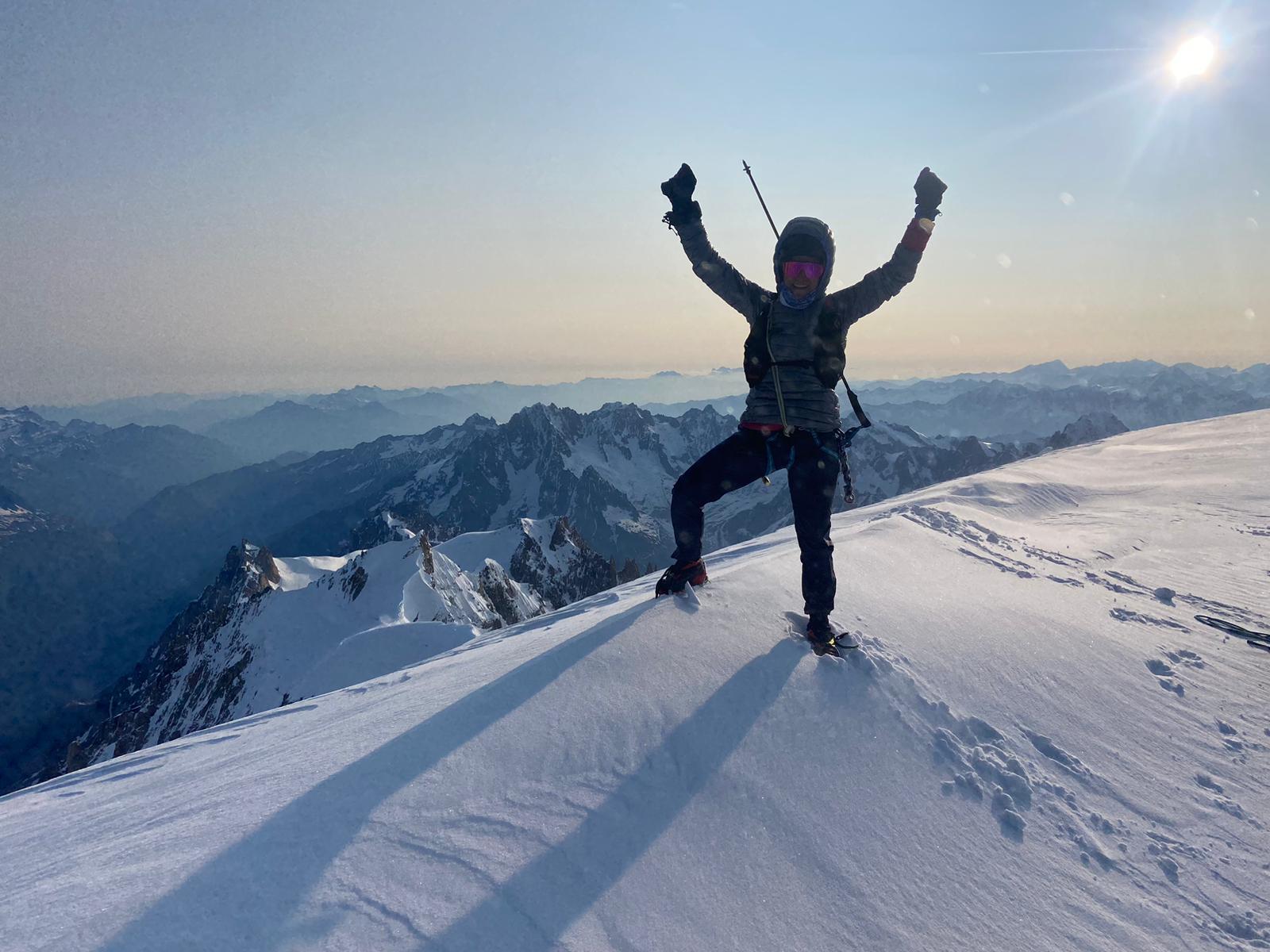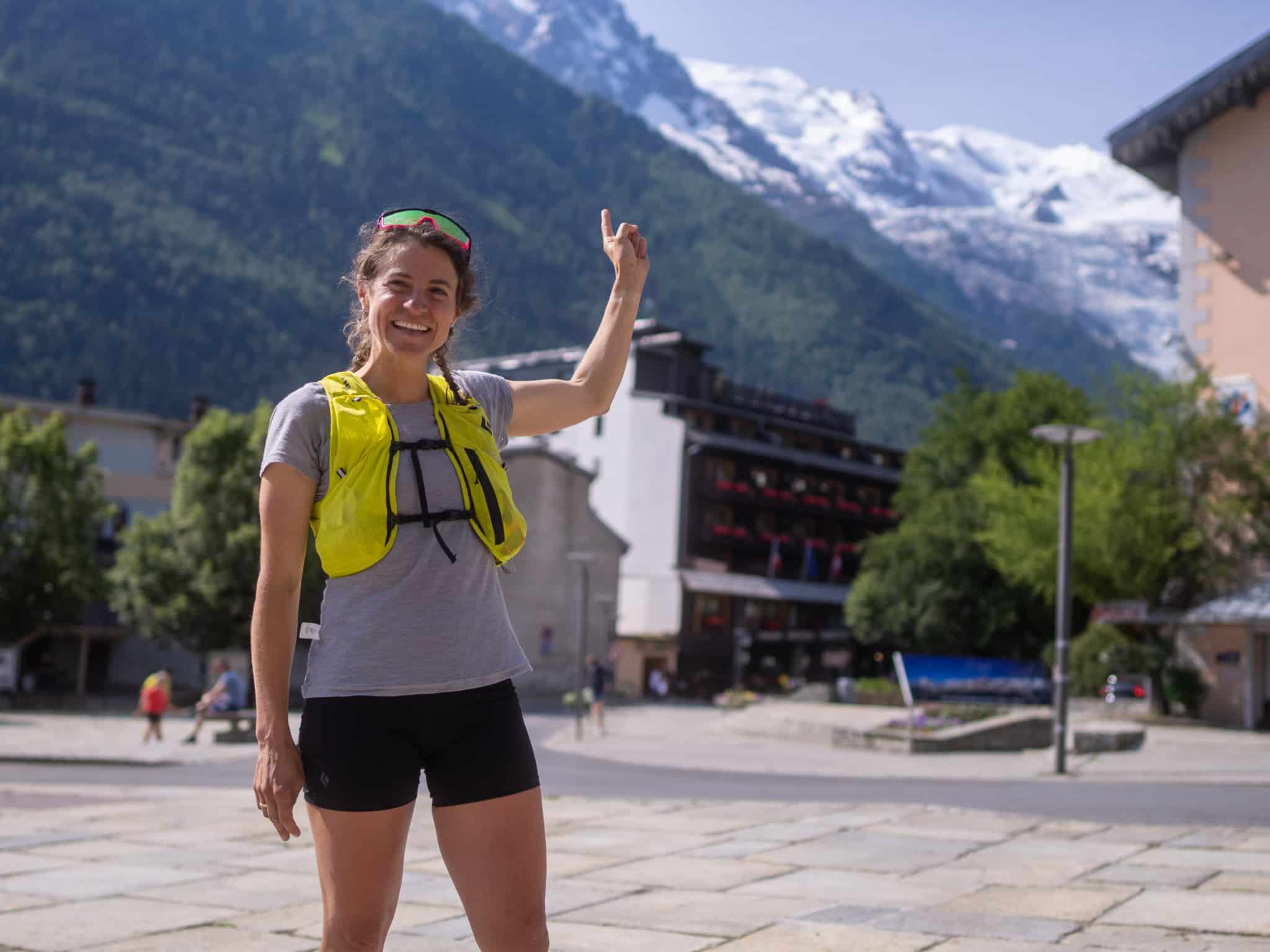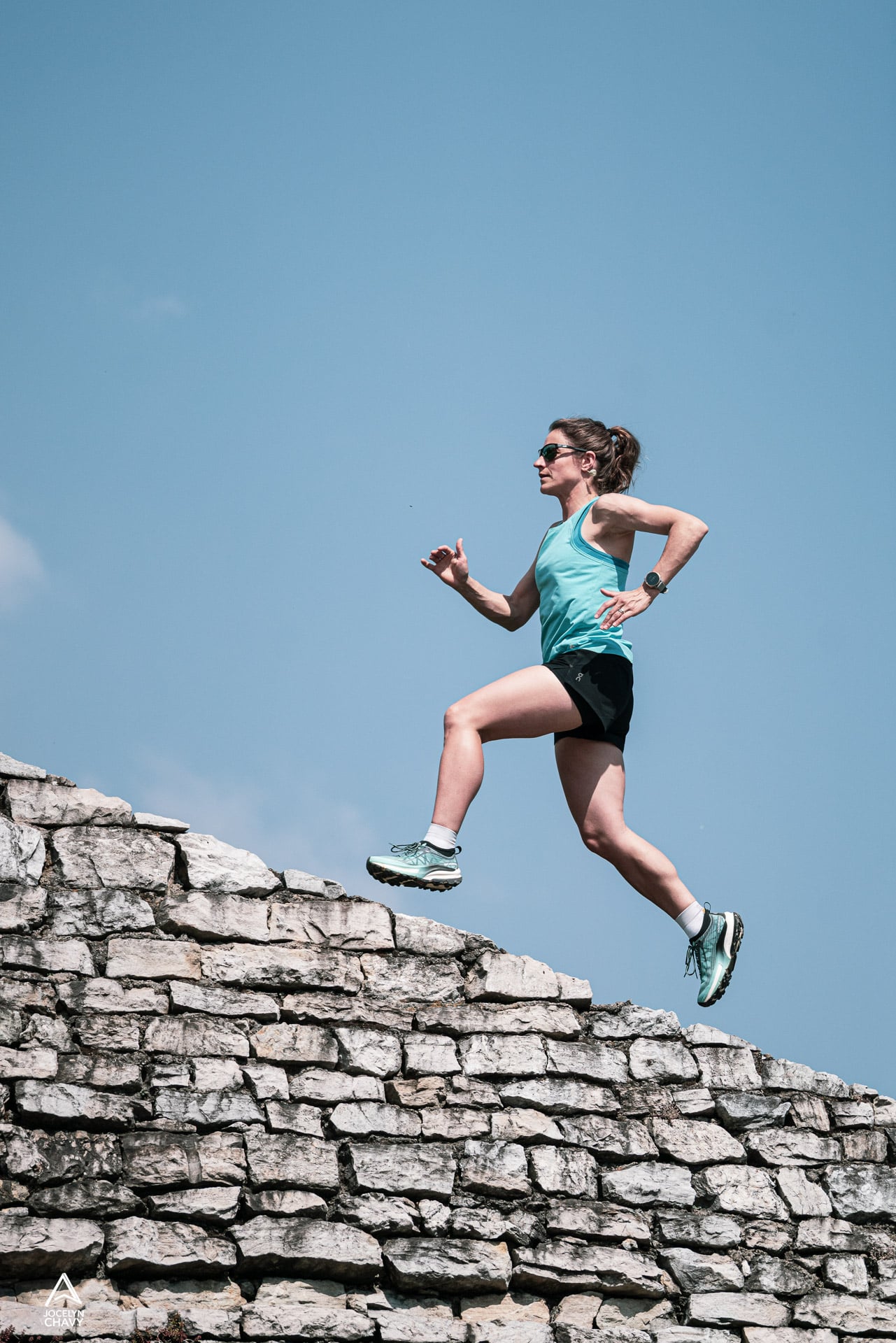For several years now, Hillary Gerardi has been shining on the podiums of the finest trail races, but her sights remain set on altitude. In 2023, she took on the highest, if not the most prestigious of Alpine records, setting a new women’s mont Blanc record in 7 hours 25 minutes round trip. This is the subject of Always Alive, the new film directed by Davina Beyloos Montaz-Rosset, previewed at the Festival Aventure & Découverte in Val d’Isère, France. Interview with Hillary and Davina.
Davina Beyloos, half of the Montaz-Rosset studio, shared the same feeling as Seb Montaz a year earlier. It wasn’t, or no longer, about making an athlete’s film, a “simple” sports project. It’s no longer that that drives the duo, but going beyond it. So when Hillary Gerardi came up with the idea of setting a record on Mont Blanc, the idea caught on. Since the glaciers – those of the Jonction – don’t always allow for easy passage – as was the case in 2021 and 2022 – since the Chamonix glaciers are suffering the full force of climate change, and since Hillary herself chose the Dôme ridge route rather than the historic Plateaux route, the film couldn’t ignore these facts. Quite the contrary, in fact.
Through the voice and presence of Heïdi Sevestre, a glaciologist who came to encourage Hillary, Davina’s film Always Alive not only recounts the record – an individual performance but also a collective adventure – but also conveys a number of messages. Firstly, that of the melting glaciers. The message of individual responsibility, whether an athlete or not: like Hillary’s, who set her record as safely as possible. A heartfelt 37-minute film, previewed at the Festival Aventure & Découverte in Val d’Isère, France. We wanted to know a little more about it by talking to the director, Davina, and Hillary.
How did you two meet?
Davina Beyloos Montaz-Rosset: Davina Beyloos Montaz-Rosset: Hillary was hitchhiking in Chamonix and Seb and I were passing through. I found her really interesting, and she called us up later to ask us to work on the project.
Basically, we didn’t want to make a film based solely on a sporting project; we needed something else to make a film. Hillary also wanted to use her record to get across a message about the environment, and more specifically about raising awareness of glacier melt. So it was really a project where we were totally aligned. I told Seb that I wanted to make a film with Hillary because she was a character that really interested me.
it really took me a while to realize that I could attempt this record,
which seemed unbeatable
How did the desire to beat the mont Blanc record come about? Had you been dreaming of it for a long time?
Hillary Gerardi : I moved to the Chamonix valley a little over 7 years ago, with a background in mountaineering and alpinism, before moving on to trail running in a more sky-running format. I wanted to combine these two disciplines: endurance and high mountain running. The women’s record on Mont Blanc was set in 2018 and it really took me a while to realize that I could attempt this record, which seemed unbeatable.
In 2020, the seed was planted. No more competitions because of the pandemic, so I went back to the high mountains, the Innominata ridge, the Aiguille Verte. One day, I took a friend to Mont Blanc. She told me I was very comfortable and that I should try for the record. I thought Emelie Forsberg was too strong [the former holder of the women’s record for climbing Mont Blanc, editor’s note]. Then all that started to sink in.
Then I kept a close eye on conditions in the mountains. We know that climate change is affecting the Alps twice as fast as the rest of the northern hemisphere, and I noticed that, for example, the Jonction passage [at the top of the Bossons glacier, editor’s note] shown in the film was not passable – in record mode, I should point out, i.e. safely and quickly – in either 2021 or 2022. So it wasn’t possible to set a record in those years. I was even beginning to wonder whether it was possible to attempt the record. The mountains change so much. That’s why I wanted to tell the story of the ascension rather than just the record itself.
With climate change, might this record not be repeated or improved?
Hillary Gerardi : Hillary Gerardi: There’s what we call inter-annual variation, so there will be years with more snow. In those years, it will be possible to attempt and beat this record.
But, Davina knows it well, I had blocked off a lot of time long before this record, because you can’t say that it will necessarily be in good conditions by mid-June, for example. You have to block out time and be ready to act when the conditions are right. For the record, I made up my mind a day and a half before the D-day! I called Davina and told her: “That’s it, it’s going to be Saturday, get ready, departure at 2am!”
a franco-american record
on a franco-italien summit
Beyond the record, this film is also a portrait of a woman
Davina Beyloos Montaz-Rosset : It’s an individual record, but it’s also a team effort, as you can see in the film. That’s Hillary’s strength: she surrounds herself with friends and competent people. This is her strength. She creates a social bond around this project. And even for my experience as a director, it was a microadventure for me! I started out alone with my camera at 1:30 in the morning. It’s like a team carrying Hillary’s project.
An international chain?
Hillary Gerardi: I’m American by birth, but I recently learned that I’m a French citizen. I was even before the record, but I was only informed recently.
So it’s a Franco-American record, on a Franco-Italian summit. But not quite on the normal route of the Grands Mulets, as shown in the film. The historic route passes through the Plateaux, under heavy seracs.
As for me, I decided to take the northern ridge of the Dôme du Goûter, precisely to avoid spending all that time under the seracs [the historic route she takes on the descent, very quickly!, editor’s note]
Davina, in your film, you talk about Hillary’s inner questioning of her own legitimacy. Is this also a question of female mountaineering?
Davina Beyloos Montaz Rosset : You don’t hear as much about women’s mountaineering as men’s. There aren’t many documentaries about women’s mountaineering [except for Mehdi Moutia’s documentary on Bouchra Baibanou, editor’s note]. However, you only have to go to French alpine clubs to see that women are very active in the mountains. So I thought it would be interesting to make a documentary about Hillary, to show that women’s mountaineering is at the cutting edge of sporting excellence. But it’s also about going beyond the gender of the protagonists.
Hillary, do you agree with Davina that women’s mountaineering has something to contribute to the (male) model of mountain conquest?
Hillary Gerardi : For this project, we wanted to put together an all-female team. I think the big question is the representation of women, because we don’t see them all the time, or we don’t see them as often as men.
There are just as many women capable of great feats, but sometimes they don’t feel legitimate. For me, it was more a question of being a woman, but also of being legitimate as a mountaineer, even though I have a lot of mountaineering experience. Ultimately, I think that this representation is extremely important because it inspires other people to go for it, to give it a try. Yes, women can bring something different to the table. But men are also capable of working as a team on this kind of project, even if that hasn’t always been celebrated in the past.
It gave people who didn’t know the mountains the impression
that they could go there in sneakers
Your choice of safety – going over the Goûter ridge rather than under the seracs – is a militant choice, from an environmental and mountaineering point of view, with measured risk-taking?
Hillary Gerardi : It’s important for me to get this message across. When Kilian Jornet was setting records at the start, people had the impression that he was taking huge risks (and he sometimes was). It gave people who didn’t know the mountains the impression that they could go there in sneakers. When people see runners in the high mountains, they sometimes hear “ah, you’re doing your Kilian”…
But if you go back in time, there was even a race at the end of the 19th century for Chamonix guides: to the Brevent and back. But times have changed, with trail equipment in the shop windows. This upsets some people who say they no longer recognize Chamonix. For my part, I wanted to answer these questions by demonstrating that a trail runner can be competent in the high mountains, by setting a good example with real safety equipment, such as crampons and not athletic spikes.
Davina Beyloos Montaz-Rosset: Davina Beyloos Montaz-Rosset: That’s why we kept the sequence in the film where Hillary talks about the Jonction, the disappearance of the German duo and so on. This allows the viewer to understand that crossing the Jonction is risky, but above all that we’re talking about high mountains, not trails, and that glaciers suffer and change. Hence the presence in the film of Heïdi Sevestre, the glaciologist, to shed light on these spectacular changes in the Mont-Blanc massif.
In other words, you can go this way to try and beat the record,
you don’t have to take the risk of staying under the seracs!
Hillary Gerardi : Hillary Gerardi: My husband, Brad, is a guide. He asked me if I was sure I wanted to beat Emelie Forsberg’s record, which takes the historic route, under the seracs. In fact, with my past – a serious mountain accident – I told myself I didn’t want to take the risk. I was going to attempt the record in my own way, with real crampons, via the north ridge – so a route about 1.5 km longer.
In the end, I was still faster, and I’m so glad I made those choices. In other words, you can go this way to try and beat the record, you don’t have to take the risk of staying under the seracs!
Hillary, we recently saw you get involved in the environment with a weekend of reflection between athletes with the Protect our winter association. Is that what being an athlete means to you: putting in a performance, but (above all) not just talking about yourself?
Hillary Gerardi : Yes, I went to see POW with other athletes like Mathieu Navillod. I wanted to see how other athletes were tackling these issues and what was being done. We talked about the role of the athlete, how to get a message across through action, how to communicate. Davina’s film is an example.
The fact that we athletes have an audience and a platform is also a responsibility. Trying to make things happen and change. In my case, it can be in a film, but also with all the brands I work with, I try to push them a little towards action.
Athletes – like everyone else, but perhaps even more than everyone else – are hypocrites in a way. We consume and travel for sport, and people might say to us: you’re not exemplary, so shut up. I think we have to accept that we’re not perfect, that sometimes we make mistakes. Kilian Jornet, for example: it’s really interesting the way he says that people will criticize him, but that it’s important enough for him to try and change things.
We also talked about the future of sport. What does “performance” really mean? Are we always going to approach performance in the same way? Is it the first person to cross the finish line, or is it the person who did it the best way?
I’m also thinking of the Piolets d’or, which take into account the ethics behind a climb, and I think that’s interesting. Will international competitions be relevant in 2050, like the UTMB? In short, even if the film isn’t about the environment, my role as an athlete is also to set a good example, and sow a seed that makes people think.
in a way, i was also responsible for the team helping me
Hillary, what are you going to do now, after the record then this film? A new record?
I’m still savoring the images! You can see the emotion, which is also that of the team that helped me. I had to decide for myself whether to go or not, and that wasn’t easy. I almost wanted Seb Montaz to say to me, go ahead, it’s okay. But it was up to me to talk to the guides and hut wardens and decide whether or not it was the right time. As a result, I carried a certain mental burden, because I knew that as soon as I made the decision I was going to activate all those people! In a way, I was also responsible for them.
Otherwise, in the film, you can see that I’m talking while running/walking: that’s because I didn’t want to go too fast and burn all my energy. If I can talk, then I’m fine. Except when I reached the bottom of the descent, where my girl friend Meg told me to go all in! As for this record and doing it again, I can already see things that could be improved. For example, on the downhill run, sliding on my buttocks, I was limited by the hard snow. It would have been better or easier if the snow had been looser. I had a sore tailbone for three weeks!






